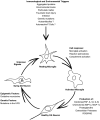Neuroinflammatory mechanisms in Parkinson's disease: potential environmental triggers, pathways, and targets for early therapeutic intervention
- PMID: 17720159
- PMCID: PMC3707134
- DOI: 10.1016/j.expneurol.2007.07.004
Neuroinflammatory mechanisms in Parkinson's disease: potential environmental triggers, pathways, and targets for early therapeutic intervention
Abstract
Most acute and chronic neurodegenerative conditions are accompanied by neuroinflammation; yet the exact nature of the inflammatory processes and whether they modify disease progression is not well understood. In this review, we discuss the key epidemiological, clinical, and experimental evidence implicating inflammatory processes in the progressive degeneration of the dopaminergic (DA) nigrostriatal pathway and their potential contribution to the pathophysiology of Parkinson's disease (PD). Given that interplay between genetics and environment are likely to contribute to risk for development of idiopathic PD, recent data showing interactions between products of genes linked to heritable PD that function to protect DA neurons against oxidative or proteolytic stress and inflammation pathways will be discussed. Cellular mechanisms activated or enhanced by inflammatory processes that may contribute to mitochondrial dysfunction, oxidative stress, or apoptosis of dopaminergic (DA) neurons will be reviewed, with special emphasis on tumor necrosis factor (TNF) and interleukin-1-beta (IL-1beta) signaling pathways. Epigenetic factors which have the potential to trigger neuroinflammation, including environmental exposures and age-associated chronic inflammatory conditions, will be discussed as possible 'second-hit' triggers that may affect disease onset or progression of idiopathic PD. If inflammatory processes have an active role in nigrostriatal pathway degeneration, then evidence should exist to indicate that such processes begin in the early stages of disease and that they contribute to neuronal dysfunction and/or hasten neurodegeneration of the nigrostriatal pathway. Therapeutically, if anti-inflammatory interventions can be shown to rescue nigral DA neurons from degeneration and lower PD risk, then timely use of anti-inflammatory therapies should be investigated further in well-designed clinical trials for their ability to prevent or delay the progressive loss of nigral DA neurons in genetically susceptible populations.
Figures

Similar articles
-
Neuroinflammation in Parkinson's disease: its role in neuronal death and implications for therapeutic intervention.Neurobiol Dis. 2010 Mar;37(3):510-8. doi: 10.1016/j.nbd.2009.11.004. Epub 2009 Nov 10. Neurobiol Dis. 2010. PMID: 19913097 Free PMC article. Review.
-
Manganese exposure exacerbates progressive motor deficits and neurodegeneration in the MitoPark mouse model of Parkinson's disease: Relevance to gene and environment interactions in metal neurotoxicity.Neurotoxicology. 2018 Jan;64:240-255. doi: 10.1016/j.neuro.2017.06.002. Epub 2017 Jun 20. Neurotoxicology. 2018. PMID: 28595911 Free PMC article.
-
Blocking soluble tumor necrosis factor signaling with dominant-negative tumor necrosis factor inhibitor attenuates loss of dopaminergic neurons in models of Parkinson's disease.J Neurosci. 2006 Sep 13;26(37):9365-75. doi: 10.1523/JNEUROSCI.1504-06.2006. J Neurosci. 2006. PMID: 16971520 Free PMC article.
-
Neuroinflammation and α-synuclein dysfunction potentiate each other, driving chronic progression of neurodegeneration in a mouse model of Parkinson's disease.Environ Health Perspect. 2011 Jun;119(6):807-14. doi: 10.1289/ehp.1003013. Epub 2011 Jan 18. Environ Health Perspect. 2011. PMID: 21245015 Free PMC article.
-
Neuroinflammation in Parkinson's disease: is there sufficient evidence for mechanism-based interventional therapy?Front Biosci. 2008 Jan 1;13:709-17. doi: 10.2741/2713. Front Biosci. 2008. PMID: 17981581 Review.
Cited by
-
Effect of Levodopa Initiation on the Gut Microbiota in Parkinson's Disease.Front Neurol. 2021 Mar 4;12:574529. doi: 10.3389/fneur.2021.574529. eCollection 2021. Front Neurol. 2021. PMID: 33746867 Free PMC article.
-
Vaccinium bracteatum Thunb. Exerts Anti-Inflammatory Activity by Inhibiting NF-κB Activation in BV-2 Microglial Cells.Biomol Ther (Seoul). 2016 Sep 1;24(5):543-51. doi: 10.4062/biomolther.2015.205. Biomol Ther (Seoul). 2016. PMID: 27169820 Free PMC article.
-
Neuromelanin activates proinflammatory microglia through a caspase-8-dependent mechanism.J Neuroinflammation. 2015 Jan 14;12:5. doi: 10.1186/s12974-014-0228-x. J Neuroinflammation. 2015. PMID: 25586882 Free PMC article.
-
Effects of hydrogen sulfide-releasing L-DOPA derivatives on glial activation: potential for treating Parkinson disease.J Biol Chem. 2010 Jun 4;285(23):17318-28. doi: 10.1074/jbc.M110.115261. Epub 2010 Apr 5. J Biol Chem. 2010. PMID: 20368333 Free PMC article.
-
Effect of Chlorogenic Acid Supplementation in MPTP-Intoxicated Mouse.Front Pharmacol. 2018 Aug 6;9:757. doi: 10.3389/fphar.2018.00757. eCollection 2018. Front Pharmacol. 2018. PMID: 30127737 Free PMC article.
References
-
- Akhmedova SN, Yakimovsky AK, Schwartz EI. Paraoxonase 1 Met-Leu 54 polymorphism is associated with Parkinson's disease. J Neurol Sci. 2001;184:179–182. - PubMed
-
- Allan SM, Tyrrell PJ, Rothwell NJ. Interleukin-1 and neuronal injury. Nat Rev, Immunol. 2005;5:629–640. - PubMed
-
- Aloe L, Fiore M. TNF-alpha expressed in the brain of transgenic mice lowers central thyroxine hydroxylase immunoreactivity and alters grooming behavior. Neurosci Lett. 1997;238:65–68. - PubMed
-
- Aloisi F. The role of microglia and astrocytes in CNS immune surveillance and immunopathology. Adv Exp Med Biol. 1999;468:123–133. - PubMed
-
- Aloisi F. Immune function of microglia. Glia. 2001;36:65–179. - PubMed
Publication types
MeSH terms
Substances
Grants and funding
LinkOut - more resources
Full Text Sources
Other Literature Sources
Medical

